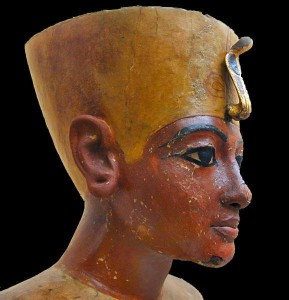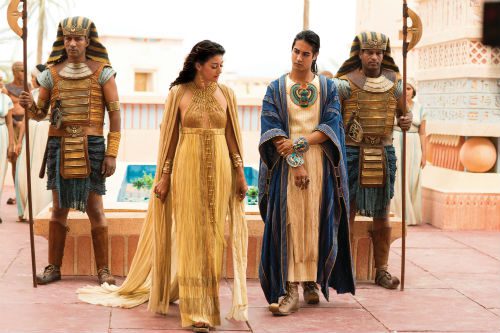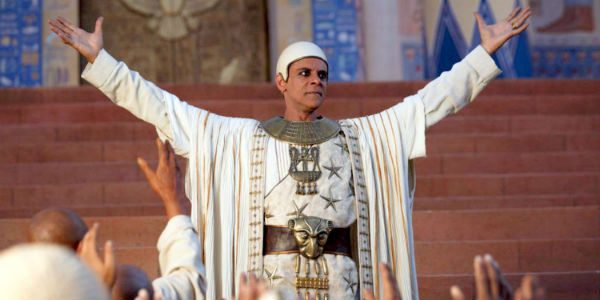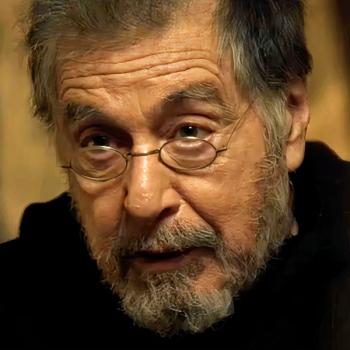TV isn’t always fussy about ethnic accuracy in casting historical dramas, but sometimes it gets pretty close.
Stranger in a Strange Land
British actor Alexander Siddig, one of the stars of the three-night, six-hour miniseries “Tut,” premiering Sunday, July 19, on cablenet Spike, was born in 1965 to an English mother and Sudanese father not far from the Nile River in Sudan, which is at modern Egypt’s southern border.
But at the age of four, his Muslim grandmother packed him off alone to his mother in England, and he’s glad she did.
“Thank God I didn’t grow up in Sudan,” he said, speaking from a hotel in Hollywood, the morning after a party for “Tut.” “A lot of my family were forced to, and were in prison for years … My grandmother put me on a plane and just prayed to her God that I would be safe.”
Although he became thoroughly assimilated into British culture — he went by Siddig El Fadil (a shortened version of his birth name) until the ’90s, when he switched to Alexander Siddig — Siddig was particularly happy to take on his “Tut” role of Amun, high priest to the famous boy pharaoh. After all, ancient Nubia, a trading partner and rival power to Egypt (there was even a dynasty of Nubian pharaohs) lay in what now is southern Egypt and northern Sudan.
“I was really a part of this world,” said Siddig. “So, it was nice to do something where I felt indigenous. I’m part of this place, which is great.”
Growing a Story From a Seed of History
 Filmed in Morocco, “Tut” spins a rollicking but almost entirely fictitious story around the short life and reign of Tutankhamun (circa 1332-1323 B.C.). He ascended to the throne at 9 or 10 but only ruled briefly after attaining his majority.
Filmed in Morocco, “Tut” spins a rollicking but almost entirely fictitious story around the short life and reign of Tutankhamun (circa 1332-1323 B.C.). He ascended to the throne at 9 or 10 but only ruled briefly after attaining his majority.
Slight, and with some skeletal abnormalities, he died at the age of 18 or 19, and the exact cause of death remains a topic for debate (“Tut” has its own theory).
While Egyptophiles will appreciate the massive, hand-painted sets — which Siddig said were mostly real, rather than CGI — there might be some eye-rolls at the luxuriant locks sported by Tut and others, especially since Egyptian art usually portrayed the aristocracy with shaved heads and elaborate wigs.
“We had to settle,” said Siddig, “for the fact that you’ve got a bunch of working actors who have to do other stuff.”
(That included Siddig, who was also in the middle of filming HBO’s “Game of Thrones.”)
They also wear an enormous amount of heavy, shiny robes. Again, this stands in contrast to Egyptian art, in which the people didn’t wear much, and what they did wear was mostly linen. But, said Siddig, consultants on “Tut” told him to not always believe what he saw painted on a wall or carved into a pillar.
“The priests did wear a lot of clothes,” he said, “and so did the aristocracy. It was a show of their wealth and ostentation. What ended up on the walls was actually more symbolic than reality.”
We do know that the title character of “Tut” was born Tutankaten during the reign of 18th Dynasty Pharaoh Akhenhaten, who threw aside Egypt’s powerful polytheistic religion in favor of a personal monotheism that made him the sole human intercessor for a sun-disk deity, called the Aten.
There are theories that Akhenaten’s religious upheaval was either inspired by Hebrew Joseph or Moses, or, conversely, inspired the concept of monotheism among Hebrews, but there’s no direct evidence for either notion. But comparisons between Akhenaten’s “Hymn to the Aten” and Psalm 104 are intriguing, if not proof of anything in particular.
What’s certain is that Akhenaten’s belief system didn’t outlive him in Egypt, and by the crowning of Tutankhamun, the original state religion was back in full force. The  kingdom’s capital was removed from Akhenaten’s desert city of Akhetaten and returned to Thebes, on the banks of the Nile.
kingdom’s capital was removed from Akhenaten’s desert city of Akhetaten and returned to Thebes, on the banks of the Nile.
On the opposite shore was the Valley of the Kings, where many royals were buried. It was there, in 1922, that Brit Howard Carter would find Tutankhamun’s tomb. Its vast array of treasures and artifacts — contrasted with most other tombs, which had been plundered at one time or another — helped make relatively unimportant King Tut, as he came to be known, one of the most recognizable figures in all of Ancient Egypt.
Blending Fact and Fiction
Playing characters based on history in Tut are Avan Jogia as the boy king, Ben Kingsley as Vizier Ay, and Nonso Anozie (Sampson in History’s “The Bible”) as General Horemheb (both of whom succeeded Tut on the throne, with Horemheb’s reign marking the end of the 18th Dynasty). Also, Sibylla Deen plays Akhenaten’s daughter Ankhe, Tut’s half-sister and wife (real name Ankhesenpaaten, later Ankhesenamun).
Playing characters purely from imagination are Kylie Bunbury as the commoner Suhad; Peter Gadiot as Tut’s longtime friend, Ka; Iddo Golberg as loyal soldier Lagus; and Siddig as High Priest Amun.
When Tut took the throne, he set about restoring the temples and earlier religious practices.
“It was a brave new time,” said Siddig. “Akhenaten tried to do what wound up being the impossible, and change the religious basis of Egypt to a monotheistic culture. The priests, who were suddenly disenfranchised, didn’t take kindly to that. They do a good job of pointing that out in the show.
“That was a really interesting part of it. I know that Akhenaten was an unpopular pharaoh, and Tut, I suppose, tried to get back to the status quo.”














